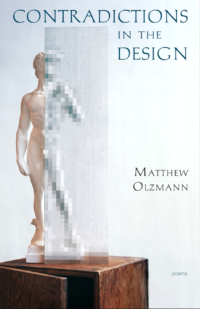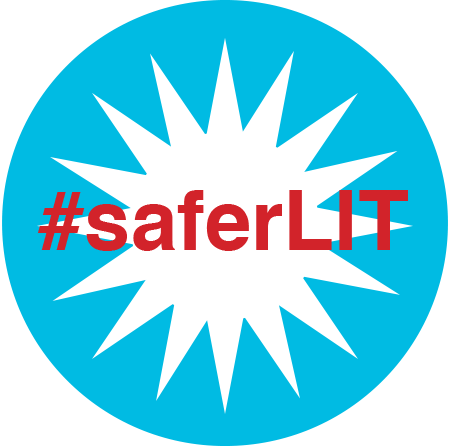ISSN: 1941-4137
POETRY THAT ENACTS THE ARTISTIC AND CREATIVE PURITY OF GLASS
POETRY THAT ENACTS THE ARTISTIC AND CREATIVE PURITY OF GLASS

Tanner Lee lives in Ogden, Utah, and studies at Weber State University. His writing has appeared in Compulsive Reader and Hobart, and is forthcoming in FRiGG and Lost Sparrow Press. You can email him at tannerlee08@gmail.com
April 13, 2017
Edited by Stephanie Kaylor
Edited by Stephanie Kaylor
Review of Contradictions in the Design by Matthew Olzmann
 Contradictions in the Design
by Matthew Olzmann
Alice James Books, 2016
Matthew Olzmann begins his second collection, Contradictions in the Design, with an image of Rodin's sculpture, The Thinker. This statue, a man sitting with this elbow on his knee, hand pressed against his face, initiates his book of poetic meditations about the paradoxes in life, spirituality, and existence.
The expression on his face:
somewhere between agony and falling asleep.
yet he holds this pose
as if no one will notice what frauds we are,
as if some world around him is about to make sense,
some answer has almost arrived. Almost.
Perhaps this book is an answer, and Olzmann wants us readers to sit, like The Thinker, and join him in his existential contemplation. Olzmann's voice is oracle, seer-like, and he navigates through life's difficult philosophical questions using terse, occasionally satirical language. In "Possum Drop" Olzmann observes that "in the name of tradition, entertainment, or superstition, / the well-meaning of our civilization will do / freaked out things … " Some of these include dropping a possum in to a crowd in North Carolina, throwing furniture from windows in South Africa, wearing bear costumes in Romania, or engaging in community fistfights in Peru. He complains that society removes itself from the violence by using tradition or entertainment as an excuse. Because of this, there is always a victim. There is always a lion or a criminal that gets killed in the colosseum: "Do you recognize the story yet? Always, that fear / in the circle. Always, that crowd: poised, ready".
In the eponymous poem "Contradictions in the Design," Olzmann asks why Beethoven was deaf, where Walt Whitman was fired for his poems, and why the designer of the Eiffel Tower was afraid of heights. He confronts the Maker, asking:
How he was alone in the frost before time began.
Drafting and erasing and already: so tired, so frazzled,
confused. The tools he used, scattered about his desk.
The ripsaw, the bucksaw, the hacksaw, and the lathe.
Olzmann makes us one with God — or, perhaps, he makes God one of us. By dissecting the oddities of being, such as the reason for suicide, why Keats is wasted on a pretentious bachelor, why a classroom full of child victims is worried about horses, and why this is the only place where God and chaos consume the same space, Olzmann builds his own Thinker. "So these are the monuments. / … let me never / take for granted / how I've been granted / this permanence, this patience / to stand forever — a stone / in this small corner of history —.” Poetry gives us permanence among the contradictions. It provides a place to confront the abstract, shine a spotlight into the void, and make significant the otherwise meaningless.
Visit Matthew Olzmann's Website
Visit Alice James Books' Website
Contradictions in the Design
by Matthew Olzmann
Alice James Books, 2016
Matthew Olzmann begins his second collection, Contradictions in the Design, with an image of Rodin's sculpture, The Thinker. This statue, a man sitting with this elbow on his knee, hand pressed against his face, initiates his book of poetic meditations about the paradoxes in life, spirituality, and existence.
The expression on his face:
somewhere between agony and falling asleep.
yet he holds this pose
as if no one will notice what frauds we are,
as if some world around him is about to make sense,
some answer has almost arrived. Almost.
Perhaps this book is an answer, and Olzmann wants us readers to sit, like The Thinker, and join him in his existential contemplation. Olzmann's voice is oracle, seer-like, and he navigates through life's difficult philosophical questions using terse, occasionally satirical language. In "Possum Drop" Olzmann observes that "in the name of tradition, entertainment, or superstition, / the well-meaning of our civilization will do / freaked out things … " Some of these include dropping a possum in to a crowd in North Carolina, throwing furniture from windows in South Africa, wearing bear costumes in Romania, or engaging in community fistfights in Peru. He complains that society removes itself from the violence by using tradition or entertainment as an excuse. Because of this, there is always a victim. There is always a lion or a criminal that gets killed in the colosseum: "Do you recognize the story yet? Always, that fear / in the circle. Always, that crowd: poised, ready".
In the eponymous poem "Contradictions in the Design," Olzmann asks why Beethoven was deaf, where Walt Whitman was fired for his poems, and why the designer of the Eiffel Tower was afraid of heights. He confronts the Maker, asking:
How he was alone in the frost before time began.
Drafting and erasing and already: so tired, so frazzled,
confused. The tools he used, scattered about his desk.
The ripsaw, the bucksaw, the hacksaw, and the lathe.
Olzmann makes us one with God — or, perhaps, he makes God one of us. By dissecting the oddities of being, such as the reason for suicide, why Keats is wasted on a pretentious bachelor, why a classroom full of child victims is worried about horses, and why this is the only place where God and chaos consume the same space, Olzmann builds his own Thinker. "So these are the monuments. / … let me never / take for granted / how I've been granted / this permanence, this patience / to stand forever — a stone / in this small corner of history —.” Poetry gives us permanence among the contradictions. It provides a place to confront the abstract, shine a spotlight into the void, and make significant the otherwise meaningless.
Visit Matthew Olzmann's Website
Visit Alice James Books' Website
Glass: A Journal of Poetry is published monthly by Glass Poetry Press.
All contents © the author.
All contents © the author.





